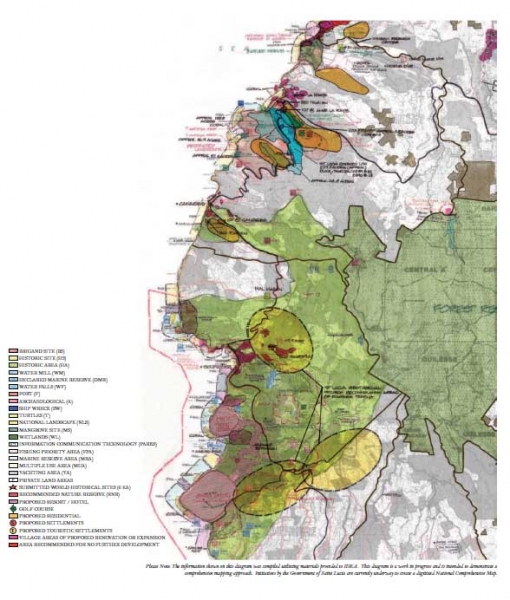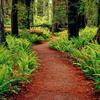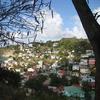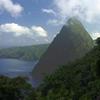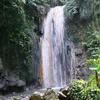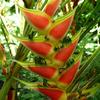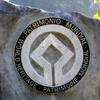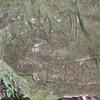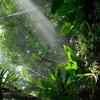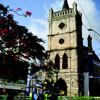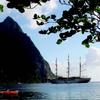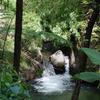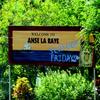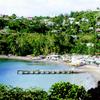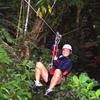Department of Finance
West-Central Quadrant
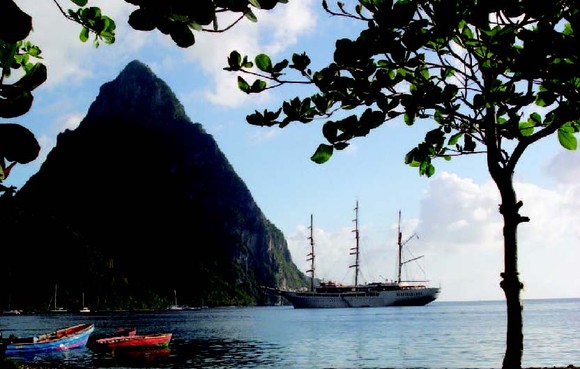
The West-Central Quadrant is said to be the most scenic area in Saint Lucia, spanning Anse La Raye, Canaries, and Soufrière. Prominent display of cultural, historic, and natural attractions makes the area particularly unique.
The iconic natural topography of Soufrière, home to the world-famous Pitons, the Sulphur Springs, and Diamond Falls, makes the area especially well-suited towards the development of eco and adventure tourism. Canaries offers natural, historic, and cultural attractions, including the Del Arts Studio and the Grand Bois Waterfall. Anse La Raye is best known as a quaint fishing village, thus capitalizing on the local market for fish and seafood would be particularly important.
Initial goals include a small cruise berth in Soufrière, as well as the creation of significantly improved roadway access throughout the entire area. An increase in visitor arrival associated with the development of a cruise berth will both increase economic activity and generate employment and entrepreneurial opportunities. Strong focus should be placed on the further development of both eco-tourism, as well as Information Communication Technology. Residential development will be crucial in this area in order to meet increasingly pressing needs.
SOUFRIERE
A "drive-in" volcano, the Diamond Botanical Gardens, and the stunning silhouettes of the Pitons make Soufrière the definitive destination for an expansive display of Saint Lucia's natural and geological phenomena. As the first permanent French settlement on the island, Soufrière abounds in historic architecture and landmarks, including the Morne Coubaril and Fond Doux Estates. Situated perfectly amidst a charmingly landscaped garden, the fifty foot Torialle waterfall is only one of several picturesque falls in the area, many surrounded by the sort of lush l ora and fauna that characterise sights like the historic Diamond Botanical Gardens.Soufrière's most iconic natural attractions are the towering Gros Piton and Petit Piton, two remarkable volcanic formations jutting dramatically from the sea to form a mountainous skyline. So striking are the Pitons, that in 2004 the United Nations Education, Scientific and Cultural Organisation named the area a World Heritage Site. The Sulphur Springs, known as the world's only "drive-in volcano," are one of Soufrière's most popular and intriguing attractions. It is these springs that Soufrière takes its name, bestowed from early French colonists dubbed the sulphurous volcanoes of the Lesser Antilles "Soufrières." The site is considered one of the hottest areas of geothermal activity in the Lesser Antilles. In 1784, the spring water was tested and found to possess similar medicinal properties to the waters of the Aix les Bains in France, prompting then Governor Baron de Laborie to build the Diamond Baths. Today, only traces of the original baths can be found at Sulphur Springs.
ANSE LA RAYE REGION
Featuring some of the i nest examples of French and English colonial architecture on the island, with many original structures dating back over one hundred years, the village and region of Anse La Raye have been historically associated with the trade of its many fishermen. Anse La Raye actually derives its name for the French word for the skate i sh, found in abundance in the coastal waters of this region. Traditional fishing boats are still handmade in the village, using distinctive materials and techniques passed on through the generations. While countless glimpses of the "real" and historic Saint Lucia can easily be sought out in this region of the island, which is home to the La Sikwi Sugar Mill and River Rock Fall. The black volcanic sand beach of Anse Cochon is a popular spot of snorkeling, largely due to the impressive shallow reefs that can be found there. Perhaps the most celebrated sight to behold is the "Seafood Friday" along the waterfront of Anse La Raye village. Here locals and tourists mingle amidst music and drink, as fishermen share fresh fish, conch, and lobster, serving the catch of the day barbecued or steamed well into the evening. This weekly community gathering has become the signature event of the region and a quintessential activity for those visitors desiring a truly immersive Saint Lucian experience. Located between Anse La Raye and Soufrière, the relatively remote and stunningly scenic Canaries area, home to several dark volcanic sand beaches and several extraordinary waterfalls, only a short distance away from the quaint Canaries village, a small fishing settlement nestled against a costal inlet. Sights such as the Grand Bois Waterfall, accessible via a stunning drive and walk through lush growth of forest and farmland, offers a tremendous close up view of the habitats of many of Saint Lucia's rare plants and animals. The name "Canaries" derives from the Carib word for Saint Lucia's traditional coal cooking pot or "Kanaree". The village also plays host to its own signature local gathering, the Canaries Creole Pot on the last Saturday of every month. With a diverse array of traditional cuisine on display, the Creole Pot, is an inviting celebration of Saint Lucia's distinctive culinary heritage and, according to locals, the definitive place to sample real Saint Lucian Kassava bread.
CANARIES
GRAND BOIS ESTATE & WATERFALL
Located in the scenic Canaries area, Grand Bois Waterfall is secluded among the lush landscape, rare wildlife, and vivid lora of the Grand Bois Estate. The Grand Bois Tour, a guided walking tour of both the forest and fall, has enormous potential for enhancement and growth to serve as a model attraction for both guests and locals to enjoy.Currently the tour provides an opportunity for guests to view the breathtaking mountainous landscape of Canaries, with a brief stopover in the village for local treats, refreshments, and facilities. From there, tour guests engage in a scenic interactive hike through the Saint Lucia countryside, into the Grand Bois Rainforest, finally ending at the spectacular Grand Bois Waterfall. A skilled and knowledgeable guide offers a detailed narrative of the history and splendor of this impressive landscape. Upon arriving at the fall, guides prepare native fruits and vegetables for sampling, while guests have the option of enjoying a swim in the waterfall's refreshing pool.
ENHANCEMENTS
At present, the Grand Bois Tour is marketed primarily to cruise guests. Tour operators encourage the possibility of enhancements and improvements to the current attraction, to increase the feasibility of physically accommodating an increased number of guests, while raising the overall quality of the experience being offered. With these improvements, the tour could be advertised to an expanded market, beginning with the inclusion of resort and hotel guests, as well as locals. Beyond tourism, the addition of an Environmental Research Centre will serve to attract scientist and students, with the opportunity to study the array of native species found at Grand Bois.
WEST-CENTRAL COMPOSITE DIAGRAM
The West-Central Quadrant is one of the most naturally and historically rich areas of Saint Lucia. Numerous environmentally sensitive areas exist in the quadrant, such as
the Pitons Management Area, the Millet Nature Reserve and Bird Sanctuary, several waterfalls, and multiple marine reserves. A signii cant number of important historic and archaeological sites can also be found in the region, particularly in the Soufrière
area. Taking this into consideration, development of the area will require a very sensitive approach in order to preserve historic sites and nature reserves, assets both culturally signii cant and crucial in maintaining attractions for the growing tourism
industry. Fertile lands around Canaries should also be conserved to continue farming operations there.
The existing scenic roadway in the West-Central Quadrant should be considered for further development in an ef ort to maintain this popular and attractive drive. Further ribbon development should be avoided and future development must be kept in scale
to preserve the natural intimacy of the area. While increased residential properties are necessary to meet growing housing needs, the focus must remain on low-density expansion. The potential of expanding the boutique tourism industry should be
explored, keeping existing elements of heritage and eco tourism as a particular concentration.
